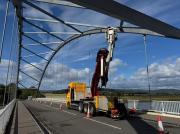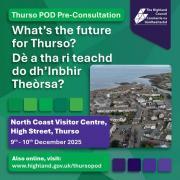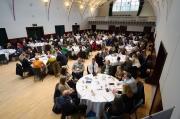Population on the up in Skye, Ross and Cromarty
5th February 2014
The demographics of Skye, Ross and Cromarty were under the spotlight today (Wednesday 5 February) as Members of the Area Committee took the opportunity to look in some detail at the results from the 2011 census.
The population of the Skye, Ross & Cromarty area has grown by 8.6% compared to the Highland average of 11.1%, with an increase in all six Council Wards, and at a local level in 65 out of 85 data zones.
The highest growth has been in the Black Isle Ward which has seen a population rise from 2001-2011 of 11.5% while the Wester Ross, Strathpeffer and Lochalsh Ward has had the lowest growth over the same period of 5.7%.
In his presentation the Council�s Research Officer Cameron Thomas highlighted that the local population growth is strongly linked to the building of new homes. Using maps to look at villages and towns, the statistics showed the greatest increases in population were in Muir of Ord (24%), Strathpeffer (15%), Avoch (15%) Alness (13%) and Kildary (13%). Seaboard is the only settlement to have seen a population decline (-2%).
On Skye the strongest growth has been in Portee North (41%), Skye Central North (18%), Skye Souh East (17%) and Sleat (15%), all linked to relatively high rates of new house building. The more densely areas of Broadford and Portree West where there is less scope for new house building , have seen declines of 1% and 9% respectively. The contrasting fortunes of Dunvegan (-3%) and Duirinish (+6%) were used by Cameron in his presentation to remind Councillors that remoteness is not an absolute barrier to growth.
Results also showed that there is a population peak in the 56 to 68 age group and that the percentage of young people aged 18 to 29 is slightly higher than in 2001.
The committee discussed that although the Census was probably carried out too early to capture the impact of growth at Nigg and Invergordon, they would like further analysis to be carried out to show the distribution of employment across the area. This would allow for a more in depth look at where the number of jobs has gone up over a decade and where they have declined. This data, alongside the population statistics will give Members a clearer insight into just how employment, economic growth and population growth are impacting specific areas.
Speaking after the presentation, Leader of the Area Committee, Councillor Hamish Fraser said: �An increase in population is very good news for our local economy and is important for keeping our communities vibrant and sustainable.
�What the census figures do is they help us to plan for the future as they highlight clearly the strong links between economic growth, new house building and population growth. I see people wanting to come to live and work in our area of the Highlands as a positive sign for the future of many of our communities. It will be interesting to get further details about how employment opportunities are linked to the demand for housing. The figures also show us that, like other areas of the Highlands, we have a large number of people in the 56 to 68 age group which should help us shape our services so we are prepared for the steady increase in the number of retired people we will have over the coming years.�
Related Businesses
Related Articles
Exciting Career Opportunities With The Highland Council Now Open For Applications
# 10 December 2025 Career opportunities with The Highland Council The Highland Council is looking to fill a variety of posts relating to civil engineering and flood risk management based in locations across the area. Included are opportunities specifically for civil engineering graduates and technicians, providing the ideal job with career progression for anyone recently qualified and ready for a varied and interesting role.
What the NC500 Research Projects Are Designed to Do - and Why They Matter for the Highlands
As the North Coast 500 approaches its tenth anniversary, it has become one of Scotland's most well-known tourism success stories. The 516-mile loop around the far north of the Highlands has been celebrated internationally, marketed as a world-class road trip, and credited with transforming visitor numbers in some of Scotland’s most remote areas.Help Shape the Future of Thurso
The Highland Council is inviting people that live, work, or study in Thurso, to come along to the public consultation events to have their say. This is an opportunity to help shape the future of Thurso, to gather views and ideas.
Are Scottish Councils Quietly Reversing Outsourcing? A Look at Insourcing, Cuts and the Highland IT Shift
A notable article in the Guardian on 6 December 2025 noted the high sums being paid by London councils outsourcing services to private firms. The article starts with the reduction in council funding by UK government since 2010.Council welcomes Visitor Levy flexibility plan
The Highland Council welcomes moves by the Scottish Government to introduce greater flexibility on how it could design a Visitor Levy Scheme for consultation. The Visitor Levy (Scotland) Act 2024 currently provides local authorities with discretionary powers to implement percentage-based levies following statutory consultation.Highland Council is reaching out for views to shape its next 26/27 budget.
As it looks to set out its forthcoming priorities, the council is seeking involvement from members of the public, including businesses, community groups, parents, and young people. All their opinions are going to be crucial in deciding how Highland Council will take on its budget challenge for 2026-2027.Have your say in Thurso's future £100million investment by attending public consultation events
Thurso is to benefit from £100m investment in education and community facilities and are rolling out the first phase of public consultations on 9 and 10 December 2025. The Highland Council is inviting people that live, work, or study in Thurso, to come along to the public consultation events to have their say; this is an opportunity to help shape the future of Thurso, to gather views and ideas.Finding new owners for empty homes - Scheme launched to help return more empty homes to active use
A new online portal has been launched to bring empty homeowners together with prospective buyers or developers with the aim of facilitating more properties to be used as homes again. Covering the whole of Scotland, this builds on the success of local pilots, referred to as "matchmaker schemes".Consideration for short term let control area in Skye and Raasay
Steps towards introducing a short term let control area have been considered by Highland Council's Isle of Skye and Raasay area committee. On Monday (1 December 2025) the committee heard evidence to justify the grounds for the introduction of a Short Term Let Control Area covering all or part of Skye and Raasay.Workforce North event spotlights Highland economy
EMPLOYERS and educators from across the Highlands have gathered to hear how a new initiative is aiming to transform the region's economy. Workforce North - A Call to Action brought together business leaders and teachers from primary and secondary schools from across the Highland Council area with a wide range of partners geared towards education, learning and skills development at Strathpeffer Pavillion.
